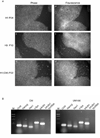Basic fibroblast growth factor support of human embryonic stem cell self-renewal
- PMID: 16282444
- PMCID: PMC4615709
- DOI: 10.1634/stemcells.2005-0247
Basic fibroblast growth factor support of human embryonic stem cell self-renewal
Abstract
Human embryonic stem (ES) cells have most commonly been cultured in the presence of basic fibroblast growth factor (FGF2) either on fibroblast feeder layers or in fibroblast-conditioned medium. It has recently been reported that elevated concentrations of FGF2 permit the culture of human ES cells in the absence of fibroblasts or fibroblast-conditioned medium. Herein we compare the ability of unconditioned medium (UM) supplemented with 4, 24, 40, 80, 100, and 250 ng/ml FGF2 to sustain low-density human ES cell cultures through multiple passages. In these stringent culture conditions, 4, 24, and 40 ng/ml FGF2 failed to sustain human ES cells through three passages, but 100 ng/ml sustained human ES cells with an effectiveness comparable to conditioned medium (CM). Two human ES cell lines (H1 and H9) were maintained for up to 164 population doublings (7 and 4 months) in UM supplemented with 100 ng/ml FGF2. After prolonged culture, the cells formed teratomas when injected into severe combined immunodeficient beige mice and expressed markers characteristic of undifferentiated human ES cells. We also demonstrate that FGF2 is degraded more rapidly in UM than in CM, partly explaining the need for higher concentrations of FGF2 in UM. These results further facilitate the large-scale, routine culture of human ES cells and suggest that fibroblasts and fibro-blast-conditioned medium sustain human ES cells in part by stabilizing FGF signaling above a critical threshold.
Figures






Similar articles
-
Basic FGF and suppression of BMP signaling sustain undifferentiated proliferation of human ES cells.Nat Methods. 2005 Mar;2(3):185-90. doi: 10.1038/nmeth744. Epub 2005 Feb 17. Nat Methods. 2005. PMID: 15782187
-
FGF2 signaling in mouse embryonic fibroblasts is crucial for self-renewal of embryonic stem cells.Cells Tissues Organs. 2008;188(1-2):52-61. doi: 10.1159/000121282. Epub 2008 Mar 11. Cells Tissues Organs. 2008. PMID: 18334814
-
FGF2 secreting human fibroblast feeder cells: a novel culture system for human embryonic stem cells.Mol Reprod Dev. 2008 Oct;75(10):1523-32. doi: 10.1002/mrd.20895. Mol Reprod Dev. 2008. PMID: 18318041
-
Culture and characterization of human embryonic stem cells.Stem Cells Dev. 2004 Aug;13(4):325-36. doi: 10.1089/scd.2004.13.325. Stem Cells Dev. 2004. PMID: 15345125 Review.
-
Toward xeno-free culture of human embryonic stem cells.Int J Biochem Cell Biol. 2006;38(7):1063-75. doi: 10.1016/j.biocel.2005.12.014. Epub 2006 Jan 23. Int J Biochem Cell Biol. 2006. PMID: 16469522 Free PMC article. Review.
Cited by
-
Fibroblast growth factor (FGF) signaling during gastrulation negatively modulates the abundance of microRNAs that regulate proteins required for cell migration and embryo patterning.J Biol Chem. 2012 Nov 9;287(46):38505-14. doi: 10.1074/jbc.M112.400598. Epub 2012 Sep 20. J Biol Chem. 2012. PMID: 22995917 Free PMC article.
-
Role of IGF1R(+) MSCs in modulating neuroplasticity via CXCR4 cross-interaction.Sci Rep. 2016 Sep 2;6:32595. doi: 10.1038/srep32595. Sci Rep. 2016. PMID: 27586516 Free PMC article.
-
Improvement of the survival of human autologous fat transplantation by adipose-derived stem-cells-assisted lipotransfer combined with bFGF.ScientificWorldJournal. 2015;2015:968057. doi: 10.1155/2015/968057. Epub 2015 Jan 28. ScientificWorldJournal. 2015. PMID: 25695105 Free PMC article.
-
Pluripotent and Metabolic Features of Two Types of Porcine iPSCs Derived from Defined Mouse and Human ES Cell Culture Conditions.PLoS One. 2015 Apr 20;10(4):e0124562. doi: 10.1371/journal.pone.0124562. eCollection 2015. PLoS One. 2015. PMID: 25893435 Free PMC article.
-
Inhibition of caspase-mediated anoikis is critical for basic fibroblast growth factor-sustained culture of human pluripotent stem cells.J Biol Chem. 2009 Dec 4;284(49):34054-64. doi: 10.1074/jbc.M109.052290. Epub 2009 Oct 13. J Biol Chem. 2009. PMID: 19828453 Free PMC article.
References
-
- Evans MJ, Kaufman MH. Establishment in culture of pluripotential cells from mouse embryos. Nature. 1981;292:154–156. - PubMed
-
- Thomson JA, Itskovitz-Eldor J, Shapiro SS, et al. Embryonic stem cell lines derived from human blastocysts. Science. 1998;282:1145–1147. - PubMed
-
- Williams RL, Hilton DJ, Pease S, et al. Myeloid leukaemia inhibitory factor maintains the developmental potential of embryonic stem cells. Nature. 1988;336:684–687. - PubMed
Publication types
MeSH terms
Substances
Grants and funding
LinkOut - more resources
Full Text Sources
Other Literature Sources
Medical
Research Materials

